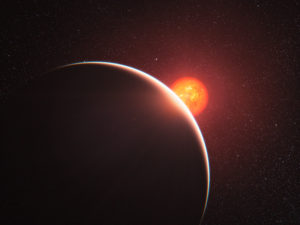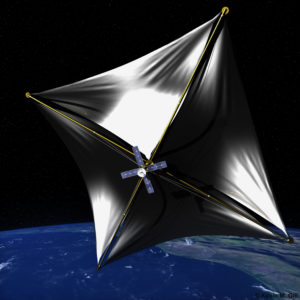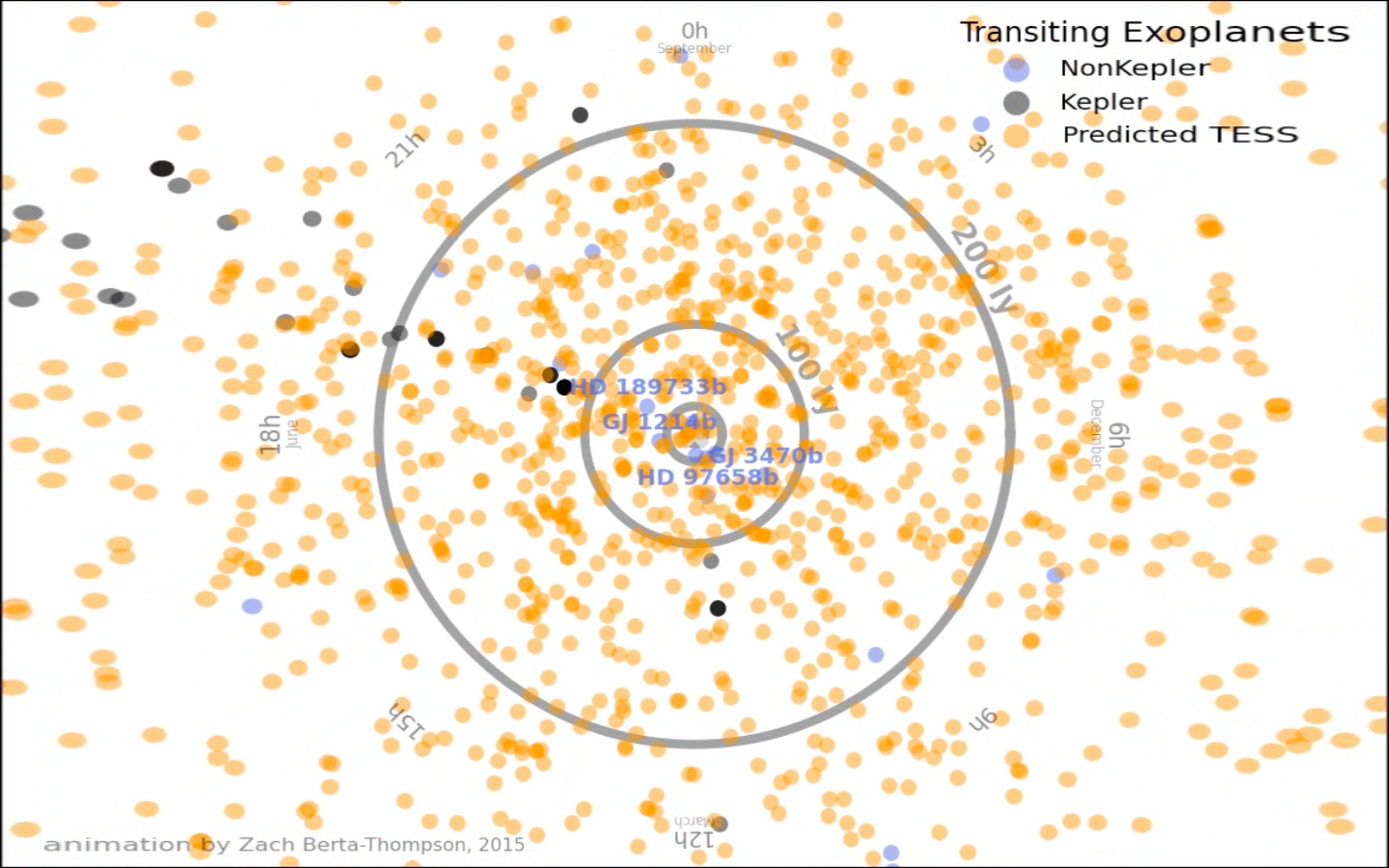exoplanets
All posts tagged exoplanets
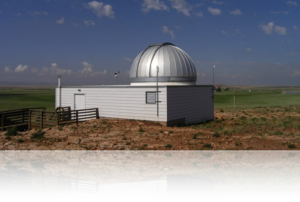
Wyoming’s Red Buttes Observatory
As part of rich tapestry of American astronomy, lots of universities across the US have small but highly serviceable observatories, with histories going back many decades. For instance, Boise State’s own on-campus observatory was installed in the late 70s, and although it’s hardy and still functional, like a lot of these observatories, it lacks capabilities that would allow its use as an active research facility. Such small, older facilities have primarily been used for outreach and teaching, rather than up-to-date research.
In the last few years, tremendous improvements in hardware and software have dramatically reduced the costs and expanded the availability of research-grade instrumentation and computational capabilities. Many of these observatories are now roaring to life and contributing to research efforts at the razor-edge of astronomy – characterizing new exoplanets, contributing to rapid-response gamma-ray burst surveys, among other projects.
However, the process of upgrading these observatories is challenging, as we’ve discovered in trying to refurbish Boise State’s observatory, and there is not a lot of guidance out there about best practices.
Recently, David Kasper of University of Wyoming Physics and Astronomy led an effort to automate Wyoming’s Red Buttes Observatory (RBO), located about 15 miles south of Laramie. Thankfully, he documented their work in a paper published late last year.
The paper provides lots of very specific technical details and even the source code the group used to make RBO a facility capable of supporting undergraduate and graduate research. For instance, RBO’s new weather station determines meteorological conditions at the observatory and posts them, every 60-s, to a public website. Automated monitoring of these conditions allows the observatory itself to decide whether the weather is conducive to observing and even to close up the dome in the case of inclement weather.
The new observatory has collected transit observations of hot Jupiters, a project right up my alley. And so, their work will provide an important roadmap for Boise State’s efforts to renew our observatory. We hope, soon, to see the shadows of distant worlds right from downtown Boise.
—
If you’d like to donate to help with refurbishing our observatory, please visit this website.
Eve Lee and Eugene Chiang of Berkeley Astronomy just posted a very interesting paper about the origins of super-Earths in ultra-short-period orbits.
The topic I’ve been interested in most in recent years is the origin and fate of these ultra-short-period planets. These little guys orbit very close to their host stars, taking, in some cases, only a few hours to circle their host stars. In other words, the year for some of these planets is shorter than a feature-length movie.
Such planets were completely unexpected before astronomers began discovering them, and it’s not at all clear where they came from – naïvely, we’d expect that they can’t form where we find them. And many of them are so small (less massive than the Earth in some cases) that tidal interactions, which can cause bigger planets to death spiral into their stars, probably don’t have much effect.
In their paper, Lee and Chiang explored the origins of short-period super-Earths, planets somewhat, but not much, bigger than Earth. This population declines the closer you get to the host star – there are more super-Earths with periods of several days (short-periods) than of several hours (ultra-short-periods), which probably tells us something about the planets’ origins.
It was thought that such planets might originate via gas disk migration. This is the gravitational give-and-take between a nascent planet and the maternal gas disk from whence it arises.
Lee and Chiang found that, surprisingly, this migration on its own would not have made enough ultra-short-period planets but too many short-period planets. Next, they tried to include tidal interactions, which made enough ultra-short-period planets but too many short-period planets.
Instead, Lee and Chiang found that they could explain the short-period super-Earths if they assumed the planets formed near where we find them (and included a little tidal migration). That’s a little surprising since the standard model of planet formation posits that the grains of dust and ice that eventually coalesce to form planets cannot exist within a few days of their host star.
So, if Lee and Chiang are right, these super-Earths, instead of growing up from tiny grains, may have grown from the collisions of 1000-km planetesimals that themselves migrated close to the host star. In this case, the origins of short-period super-Earths may have been particularly violent.
With 50-plus attendees, Friday’s event was a great success. Lots of great questions and feedback from the audience.
The next event will take place on Friday, Apr 7 at 7:30p with a talk from Prof. Rory Barnes of U Washington.
Dr. Penev was kind enough to share his presentation with me, and I’ve posted it below.
And our Pony Up Campaign finished on Sunday evening. Thanks so much to all our donors, particularly Mat Weaver, Danielle Weaver, Axel & Nancy Kappes, Scott Ki, Rex Hanson, Sonja Ward, and several very generous anonymous donors. Thanks to you all we will be able to pay for seven site visits around the state.
 Boise State’s research computing group is hosting a conference today and tomorrow on scientific computing. Along with several others, I was invited to give a 7-min, lightning talk about our research group‘s use of computing.
Boise State’s research computing group is hosting a conference today and tomorrow on scientific computing. Along with several others, I was invited to give a 7-min, lightning talk about our research group‘s use of computing.
One of the research computing things we do is time-series analysis to look for new planets in data from the Kepler/K2 Mission. So I talked about the new planets our group has helped find – my talk is below.
Very neat paper this week from René Heller and Michael Hippke exploring the exploration of the recently discovered planetary system around Proxima Centauri.
Proxima Centauri is the closest star to the Earth (only 4 lightyears away), and last year, an Earth-sized planet was found around it, opening to door to the very real possibility of a mission to an exoplanet.
After the planet’s discovery, the Breakthrough Starshot project proposed using solar sails and lasers to accelerate a tiny spacecraft to the system. Weighing only a few grams, the spacecraft could be accelerated to 20% the speed of light, giving a travel time to the system of about 20 years. Of course, the drawback to such a short trip is that the spacecraft would quickly zip past the planet, so the mission would have only seconds to collect data.
Building on that idea, Heller and Hippke pointed out that, as long as you didn’t mind waiting a little longer to get there (about 100 years), you could send the spacecraft at a low enough velocity that the solar sail could be used to slow the spacecraft on the other end. That would give you years to collect data, instead of seconds.
Key to their solution is the idea that you could slowly turn the solar sail, similar to tacking in the wind, to optimally slow and steer your 10-gram spacecraft. The animation below shows the basic idea.
With such a small spacecraft, there wouldn’t be a lot of room for moving parts to turn and orient the solar sail. To solve this problem, Heller and Hippke suggest the sail could be made of nanocrystals-in-glass whose reflective properties could be tuned to torque the spacecraft using the stellar photons themselves.
Of course, there are still zillions of technical problems to solve for such a mission (not to mention the difficulties of obtaining centuries-long NASA funding), but this study adds one more piece to the growing possibility of interstellar exploration.
A friend and colleague, Prof. Hannah Jang-Condell, invited me to visit her home department, the Physics and Astronomy Dept. at University of Wyoming. Having never been to Laramie, I was happy to accept.
I gave two presentations while at Wyoming, one to the geology dept. about our work on martian dust devils and another our SuPerPiG’s work looking for ultra-short-period planets. I’ve included my presentations below.
Geology Talk
Physics/Astronomy Talk

Glint from a sea on Saturn’s moon Titan. From http://www.jpl.nasa.gov/spaceimages/details.php?id=PIA18433.
Our spring semester journal club opened with a nice review paper on finding habitable planets from Tyler Robinson, NASA Sagan Fellow at UC Santa Cruz.
The traditional definition of a habitable planet is “a world that can maintain stable liquid water on its surface”, but, as astrobiologists have explored for decades, this definition involves a vast flotilla of assumptions and very narrowly focuses our search for Earth-like life.
Even with all its limitations, this definition provides a very useful and practical starting point – at the first order, whether a world can host stable liquid water on its surface depends on the amount of sunlight it receives and whether it has a sufficiently thick (but not too thick) atmosphere.
Having found countless worlds outside our solar solar, astronomers are able to assess whether those worlds satisfy these conditions using observations we can already make, and a few dozen (probably) do.
In his review paper, Robinson discusses the observational and theoretical techniques astronomers can employ in the near future to take the next steps in deciding whether a world really has liquid water. Among the different approaches he describes, one is the most striking is the search for the glint from an alien ocean.
Robinson points out that Galileo was the first person to propose how to look for an ocean on another world. In his controversial Dialogue Concerning the Two Chief Worlds Systems, he says that, if the Moon had seas, “the surface of the seas would appear darker, and that of the land brighter”, just as on Earth.
Seas can also appear very bright compared to land, given the right observing geometry: seas exhibit specular reflection – this is the same effect you see looking out a plane’s window when the Sun reflects off the ocean. So looking for the glint provides a way to find large bodies of water on a distant world. Indeed, the first extraterrestrial oceans were found on Saturn’s moon Titan using this method, and one of the sea glints now frequently observed by the Cassini mission is shown in the figure at left.
Of course, we don’t have spacecraft orbiting any extrasolar worlds (yet), so we can’t resolve individual points on their surfaces. But, as discussed by Robinson, as they orbit their host stars, some of those worlds line up the right way that we could see a spike in the total amount of light coming from the planets. Observing such a spike over and over again whenever the planet was in the right geometry would be a strong hint that it had a large body of liquid reflecting sunlight. Given a little more information about planetary conditions, we could confidently infer such a planet had liquid water on its surface.
Amazingly, astronomers have used Earthshine reflected from the Moon to indirectly observe sea glints from the Earth. And so we’ve actually detected oceans on two worlds using distant spacecraft (if you let me call the Moon a “spacecraft”). As Robinson’s review implies, astronomers are probably on the cusp of finding oceans on extrasolar worlds. From there, it’s just a hop, skip, and a jump to finding life.
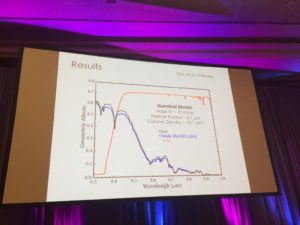
Figure from Gao’s talk, showing the spectrum of a planet before (blue and black lines) hazes and after (red line). The molecular features are almost completely wiped out by the hazes.
On day two of the AAS 229th meeting, I attended the morning session on exoplanet characterization and theory, which focused on atmospheric characterization. Several great talks, but one that made an impression on me was Peter Gao‘s presentation on sulfur hazes in hot Jupiter atmospheres.
Gao discussed work from Kevin Zahnle at NASA Ames showing that UV photolysis can transform even small amounts of gaseous sulfur in a hot Jupiter’s atmosphere into significant amounts of polymer haze. Something that has become a running motif in exoplanet atmosphere studies, these hazes discombobulate the spectrum of light emerging from a planet’s atmosphere, completely masking the signatures of other atmospheric components. This is bad news if, say, you wanted to determine the composition of a planet using light reflected from its atmosphere.
In the afternoon, I was fortunate to attend Sean Carroll‘s plenary talk “What We (Don’t) Know About the Beginning of the Universe”. It was a fascinating tour of all the different ideas about the origin of the universe, including The Big Bounce, baby universes hidden inside black holes, and the idea that the universe may have no beginning and no end. The best part of the talk, for me, was the end, when Carroll showed us a stern letter from a 10 year old skeptic sent to him in a response to an NYT article in which Carroll was quoted:
I Don’t know if you Exist But I Do! I bo not Agree with your Articl and I Do not Beleave that “MOMBO-JOMBO” if you do … Well! it’s Disturbing thought But I know How to Deal with it! I will Not let the Wolb Disiper under My Nose But if you Do I cant say I’m sorry!
Sincerely
a ten year old who knows a little more than some Pepeol!
George Wing
ps. some peopl Have a little to Much time.
Just brilliant!
Unfortunately, I had to depart for home shortly thereafter, so I’m missing the rest of the meeting. So here endeth my blog series on the meeting. Our fall semester at Boise State starts next week, though, and I plan to have weekly (maybe even semi-weekly) updates on the blog, so stay tuned.
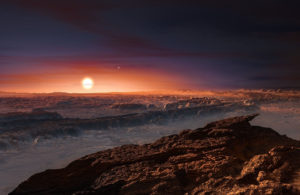 A very active and engaging morning session on detecting exoplanets via the transit method on AAS 229 Day 1. Lots of good talks (although all of the talks were by male astronomers) and probing but polite questions (again, mostly by male astronomers – interesting study on these trends here). A few talks stuck out in my mind.
A very active and engaging morning session on detecting exoplanets via the transit method on AAS 229 Day 1. Lots of good talks (although all of the talks were by male astronomers) and probing but polite questions (again, mostly by male astronomers – interesting study on these trends here). A few talks stuck out in my mind.
Aaron Rizzuto from UT Austin looked for transiting planets in stellar clusters spanning a range of ages using data from the K2 Mission and found there seem to be fewer hot Jupiters in clusters 10 million years old than there are in older (hundreds of millions of years old) clusters. He suggested that this may mean it takes 100s of millions of years for the migration that makes hot Jupiters to take place. That would probably rule out one standard model for making hot Jupiters, namely gas disk migration, since that probably takes place within a few 10s of millions of years.
Dave Kipping of Columbia University discussed his search for transits of Proxima b, the recently discovered, Earth-sized planet just four light years from Earth. Unfortunately, the host star, Proxima, is a highly variable star due to almost constant flaring. As a result, it would be very difficult to see the planet’s transit – as Kipping said, it requires wading through “a sea of variability”. However, Kipping and his group struggled valiantly to recover the transit using data from the Canadian MOST satellite, and it looks like the planet just does not transit. So we probably won’t know the planet’s radius (at least not for a long time). Bummer.
The last talk of the session was from George Ricker, the PI of the TESS mission, the follow-up mission to Kepler, about TESS’s status and prospects. Apparently, the mission will observe more than 2 million stars! Orbiting many of those stars will be nearby habitable planets, and Ricker showed an amazing simulation of where those stars might be found (courtesy of Zach Berta-Thompson of UC Boulder), a still from which is shown below.
